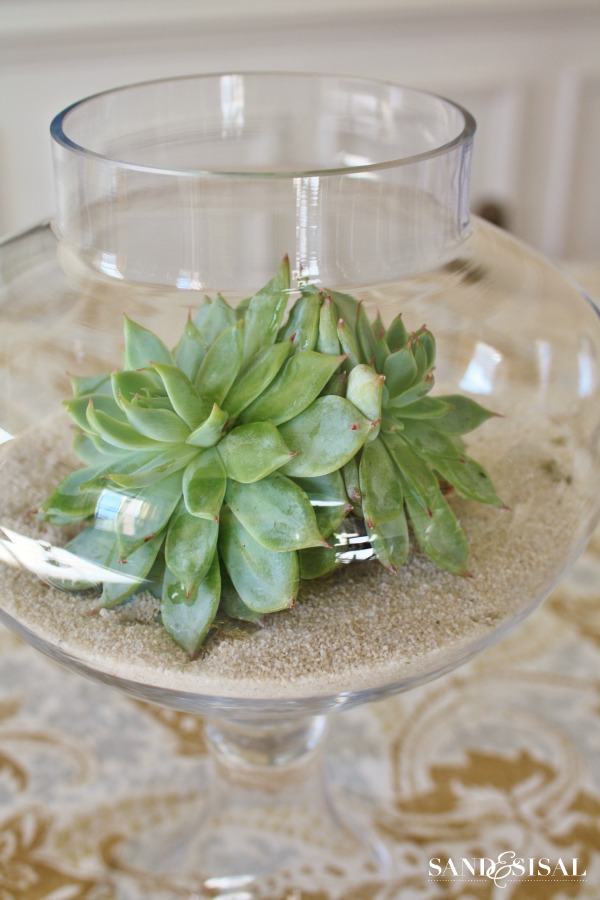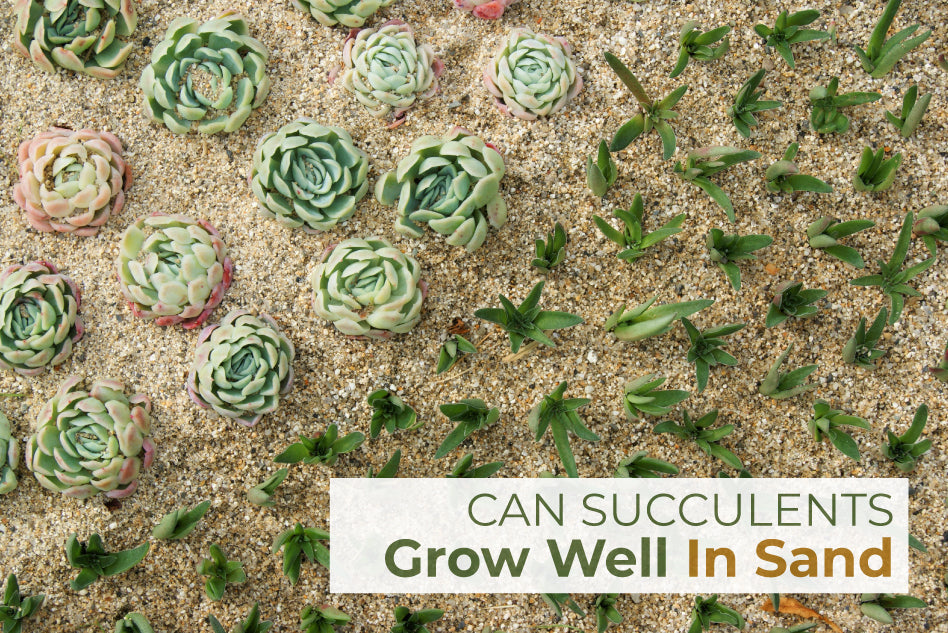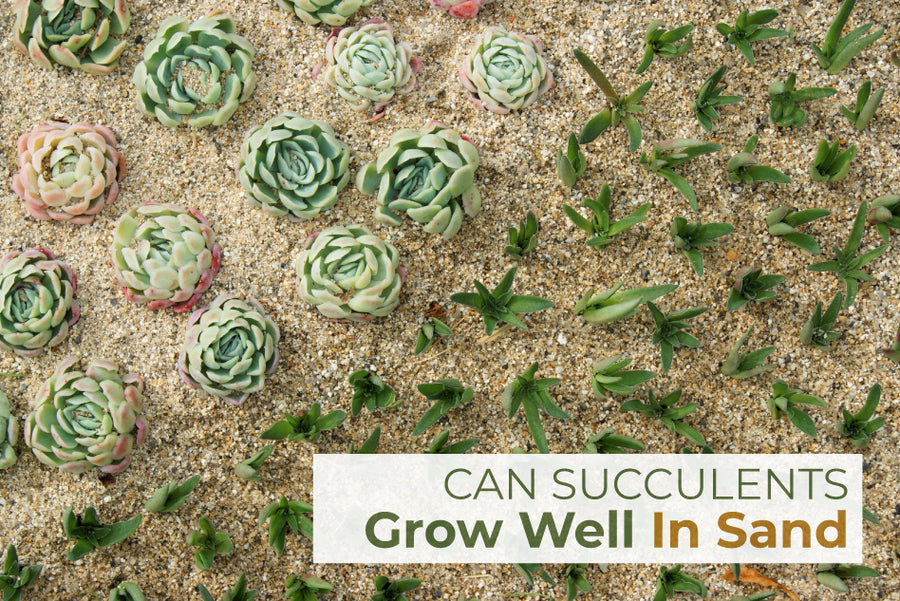Imagine transforming a simple bowl of sand into a lush, vibrant oasis. You might wonder if succulents can thrive in such a minimalist setting.
The idea of growing these resilient plants in sand is intriguing, and you are about to discover why. This concept taps into your desire to simplify and beautify your living space with minimal effort. As you explore this possibility, think about the blend of elegance and sustainability it offers.
You’ll uncover the secrets of nurturing these hardy plants, even in the most unconventional environments. So, if you’ve ever felt drawn to the simplicity and beauty of succulents, this article is your chance to learn how to make them flourish in sand.
Succulents And Their Natural Habitat
Succulents thrive in dry, sandy environments, perfectly suited for their natural habitat. Sand offers excellent drainage, preventing root rot, a common problem for these hardy plants. While sand alone lacks nutrients, succulents adapt well, storing water in their leaves and minimizing their need for rich soil.
Succulents are a captivating group of plants known for their unique ability to thrive in some of the harshest environments on Earth. Their natural habitats tell a fascinating story of resilience and adaptation. Imagine arid deserts and rocky terrains where water is scarce, yet these plants flourish with their thick, fleshy leaves and stems. They have evolved to store water efficiently, making them a popular choice for gardeners worldwide. But can they grow in sand? Let’s delve into their natural habitat and learn more.
Adaptation To Arid Environments
Succulents are masters of survival in dry conditions. They have evolved several adaptations that allow them to conserve water. Their leaves, stems, and roots are designed to store moisture. This makes them perfect for places where rain is a rare event. If you’ve ever visited a desert, you might have seen how these plants seem to defy the odds. They remain green and lush while everything else is dry and withered. This adaptation isn’t just physical. It’s a testament to their will to survive. They have a slow growth rate, conserving energy and resources. Their waxy coating reduces evaporation, keeping precious water inside. So, when you see a succulent thriving, remember it’s a little warrior against nature’s challenges.
Typical Soil Composition
Succulents naturally grow in well-draining soil. This often includes a mix of sand, gravel, and loose rock. Have you ever wondered why this combination works so well? It allows water to drain quickly, preventing root rot. Sand is a significant component in their native soil. It ensures the plant doesn’t sit in water, which could be detrimental. You might think that planting succulents in regular garden soil is sufficient. But, regular soil can retain too much moisture. Try mixing sand with your soil to mimic their natural habitat. This small change can make a big difference in your succulents’ health. Next time you’re potting a succulent, think about the desert and choose your soil wisely. Are you ready to experiment with your succulents? Understanding their natural habitat might just be the key to their thriving in your home.

Credit: www.sandandsisal.com
Characteristics Of Sand As A Growing Medium
Succulents are popular for their low maintenance and unique beauty. But can they thrive in sand? Understanding the characteristics of sand as a growing medium is key. Sand has unique features that affect plant growth. Let’s explore these characteristics.
Texture And Drainage
Sand has a gritty texture. It feels rough and coarse. This texture allows water to drain quickly. Good drainage is crucial for succulents. Too much water can cause root rot. Sand prevents water from staying too long. But, this fast drainage can also be a challenge. It requires careful watering. Succulents need just the right amount of moisture.
Nutrient Content
Sand lacks nutrients. It doesn’t hold nutrients well. Plants need nutrients to grow. This is a downside of using sand alone. Succulents can survive in low nutrient conditions. But they still need some nutrients to thrive. Adding organic matter can help. It can improve nutrient content. A balanced mix supports healthier growth.
Benefits Of Growing Succulents In Sand
Succulents thrive in sandy soil due to excellent drainage and reduced risk of root rot. The natural habitat of succulents often includes sandy environments, making sand an ideal medium for growth. Sandy soil also warms up quickly, promoting healthy root development.
Growing succulents in sand might seem unconventional, but it offers unique benefits that could transform your gardening experience. Sand, often overlooked, provides a distinct environment that supports the natural habitat of these resilient plants. If you’ve struggled with soil mixtures, sand might just be the solution you need.
Enhanced Drainage
One of the biggest advantages of using sand is its excellent drainage capabilities. Unlike traditional potting soil, sand allows water to pass through quickly, preventing overwatering. This is crucial for succulents, which are prone to water retention problems. Have you ever noticed the natural habitat of succulents? They thrive in arid regions where water drains swiftly. By using sand, you replicate this environment, ensuring your plants get just the right amount of moisture.
Reduced Risk Of Root Rot
Root rot is a gardener’s nightmare. It sneaks up silently and kills your beloved plants before you even realize there’s a problem. Sand helps mitigate this risk effectively. Because it doesn’t retain moisture, the chances of your succulent sitting in soggy conditions decrease dramatically. A friend of mine switched to sand after losing several succulents to root rot, and she hasn’t looked back since. How many plants could you save by making this simple change? Growing succulents in sand offers more than just an aesthetic appeal; it provides practical benefits that align with the needs of these hardy plants. By enhancing drainage and reducing the risk of root rot, sand can be your secret weapon for a thriving succulent garden. Have you tried growing succulents in sand yet? Give it a shot and see how your plants respond to this natural setup.

Credit: www.youtube.com
Challenges Of Sand Cultivation
Growing succulents in sand presents unique challenges. Sand lacks nutrients and retains water poorly, making plant care tricky. Selecting suitable succulent types and monitoring water levels are crucial for success.
Growing succulents in sand can be a fascinating endeavor. However, it presents unique challenges that you need to tackle. Understanding these obstacles can help you create a thriving environment for your succulent friends. Let’s dive into the challenges of sand cultivation.
Nutrient Deficiency
Sand is notorious for its lack of nutrients. Unlike soil, sand doesn’t hold onto the essential minerals that succulents need to grow. This can stunt growth and lead to unhealthy plants. You might notice your succulents appearing weak or discolored. To combat this, consider adding a balanced fertilizer. Look for one high in phosphorus and potassium. These nutrients are vital for strong roots and vibrant foliage. Imagine your succulents as a recipe that needs just the right ingredients. Without nutrients, it’s like baking without sugar. The result is flat and flavorless.
Water Retention Issues
Water retention is another hurdle when growing succulents in sand. Sand drains quickly, often leaving your plants thirsty. Succulents need just enough water to keep their roots moist without drowning them. Try watering more frequently but with smaller amounts. This helps maintain moisture without causing root rot. Think of sand as a sieve. Water slips away, leaving behind dry soil. Your mission is to find the sweet spot for hydration. Have you ever noticed how quickly beach sand dries after a wave? Your succulents face the same challenge. Balancing water levels is crucial. By addressing these challenges, you can set your succulents on the path to success. What strategies have you found helpful in managing these issues? Engage with the community and share your experiences!
Techniques For Successful Sand Cultivation
Succulents are hardy plants that can survive in harsh conditions. Growing succulents in sand requires special care. Sand is low in nutrients and retains little water. But with the right techniques, sand can be a suitable medium. Discover how to cultivate succulents successfully in sand.
Supplementing Nutrients
Sand lacks essential nutrients for plant growth. Use a balanced fertilizer to provide necessary minerals. Choose a fertilizer with nitrogen, phosphorus, and potassium. Apply it sparingly to avoid overfeeding. Organic options can also enhance nutrient content. Mix compost into the sand for a natural boost. This enriches the soil and improves plant health.
Watering Strategies
Succulents need careful watering in sandy soil. Sand drains quickly, so adjust watering frequency. Check the soil moisture before watering. Let the top layer dry out between sessions. Overwatering can harm succulents. Use a spray bottle for controlled watering. This prevents root rot and keeps the plant healthy.
Alternative Soil Mixes For Succulents
Succulents can thrive in sand, but it needs good drainage. Sand alone might not provide enough nutrients. Mixing sand with potting soil or perlite can create a better environment. Ensure the mix is well-draining to prevent root rot. This helps succulents stay healthy and vibrant.
Alternative Soil Mixes for Succulents Succulents can be picky about their soil needs. While sand alone isn’t the perfect medium, mixing it with other materials can create a more suitable environment. This is where alternative soil mixes come into play. By blending sand with other elements, you can ensure your succulents thrive, even if you’re short on traditional potting soil.
Combining Sand With Other Materials
You might wonder how to make sand work for your succulents. The trick is to combine it with other materials. Sand can be mixed with perlite or pumice to enhance drainage. A blend of sand, potting soil, and gravel can also do wonders. This mixture mimics the natural environment of succulents, offering better aeration and water management. Consider adding coconut coir for improved moisture retention. It holds water without becoming soggy, which is ideal for succulents that prefer dry conditions. By experimenting with these combinations, you create a custom soil mix that suits your plant’s needs.
Comparative Benefits
Why should you bother with alternative mixes? The benefits are clear. A sand-heavy mix can prevent root rot by ensuring excellent drainage. You reduce the risk of overwatering, which is a common issue with succulents. Using a mix with perlite or pumice lightens the soil, making it easier for roots to spread. This promotes healthy growth and helps your succulents establish quicker. Another benefit is cost-effectiveness. Many of these materials are affordable and easy to find. You can tailor your soil mix to your budget and the specific needs of your succulents. Have you tried creating your own soil mix? How did it affect your succulents’ growth? By experimenting with different materials, you can find the perfect balance for your green companions.
Real-life Examples And Case Studies
Succulents are hardy and adaptable. They can thrive in various environments. Many wonder if they can grow in sand. Real-life examples show that they can. Understanding these examples helps in successful cultivation.
Successful Sand Cultivation
In California, enthusiasts have grown succulents in sandy soils. They used sand from nearby deserts. The results were vibrant and healthy plants. In Australia, a gardener tried a mix of sand and gravel. Her succulents flourished with minimal watering. She discovered that the sand drained water well. This prevented root rot, a common succulent issue.
Another case in Arizona involved a small urban garden. The gardener used pure sand as a medium. He added organic fertilizer regularly. The succulents grew strong and colorful. His success inspired neighbors to try similar methods.
Lessons From Failure
Not all attempts succeed. In Florida, a novice grower faced challenges. He planted succulents in beach sand. The salt content was too high. The plants struggled and wilted. Learning from this, he switched to washed sand. The succulents began to recover.
In Texas, a gardener used fine-grained sand. It compacted around the roots. This led to poor drainage and root suffocation. Realizing the mistake, she mixed coarse sand with soil. Her next batch of succulents grew much better.
These cases show that choice of sand is critical. Each failure provides a learning opportunity. Adjustments can lead to successful succulent growth in sand.

Credit: succulentsbox.com
Frequently Asked Questions
Can You Grow Succulents In Just Sand?
Succulents can grow in sand, but they thrive better in a mix of sand, soil, and grit. Sand alone lacks nutrients and drainage may be inadequate. For healthier growth, blend sand with potting soil and perlite. Ensure proper sunlight and watering for optimal succulent care.
How To Grow Succulents Without Soil?
Grow succulents without soil using a hydroponic system. Use substrates like perlite or clay pebbles for support. Provide nutrients through water-soluble fertilizers. Ensure proper light and humidity levels. Regularly monitor water pH and nutrient concentration for healthy growth.
Can I Use Sand As Potting Soil?
Sand alone isn’t ideal as potting soil. It lacks nutrients and drainage capacity. Mix sand with organic matter like compost or peat moss for better results. This combination improves soil structure, drainage, and nutrient supply, making it suitable for potted plants.
Always ensure a balanced mix for optimal plant health.
Can You Plant Succulents In Beach Sand?
Planting succulents in beach sand isn’t ideal. Beach sand lacks nutrients and drains too quickly for succulents. Mix sand with potting soil or cactus mix for better results. Ensure proper drainage and occasional watering to keep your succulents healthy. Adjust the soil mix based on your succulents’ specific needs.
Conclusion
Succulents can thrive in sandy environments. Their roots adapt well to sand. Sand offers good drainage, preventing root rot. Choose the right succulent for sandy soil. Some species handle sand better than others. Mixing sand with potting soil improves growth.
Always check the plant’s needs. Water wisely; sand dries quickly. Too much water harms succulents. Bright light is vital for healthy succulents. Monitor your plant’s progress. Adjust care as needed. Success in sandy soil is possible with the right approach.
Enjoy nurturing your sandy succulent garden. Witness the beauty of resilient plants.

